belt MERCEDES-BENZ SPRINTER 2019 MY19 with 7” screen
[x] Cancel search | Manufacturer: MERCEDES-BENZ, Model Year: 2019, Model line: SPRINTER, Model: MERCEDES-BENZ SPRINTER 2019Pages: 354, PDF Size: 6.15 MB
Page 26 of 354

Symbols
..................................................... 4At
agl ance ................................................. 6
Cockpit ........................................................ 6
Instrument clus ter ....................................... 7
Overhead control panel ............................. 10
Door control panel .................................... .14
Emergencies and breakdowns ................... 16Genera
l notes.......................................... 18
Environmental pr otection .......................... 18
Mercedes-Benz Genuine Parts ...................18
Information about attachments, add-
on equipment, ins tallations and con‐
ve rsions .................................................... .19
Operating Instructions ...............................20
Service and vehicle operation ...................20
Operating saf ety ........................................ 21
Declarations of conformity ........................ 22
Diagno stics connection ............................ .22
No tes on changes tothe engine output ..... 23
Qualified specialist workshop .................... 23
Ve hicle registration ................................... 23
Cor rect use of theve hicle .........................23
Multi Purpose Vehicle ................................ 24
Information on problems with your
ve hicle .......................................................24
Re porting saf ety defects ............................ 24
Limited Warranty ...................................... .24
QR codes forre scue card .......................... 24
Data storage ..............................................25
Copyright .................................................. .27Occupant saf
ety...................................... 28
Re stra int sy stem ........................................28
Seat belts .................................................. 30
Airbags ...................................................... 32
Children in theve hicle ...............................34
No tes on pets in theve hicle ......................40 Opening and closing
...............................41
SmartK ey................................................... 41
Doo rs........................................................ 44
Sliding door ............................................... 45
Electrical sliding door ................................ 46
Re ar-end doors .......................................... 50
Pa rtition sliding door .................................. 51
Electrical step ............................................ 52
Side window ..............................................53
Anti-theft pr otection ..................................55 Seats and
stowage .................................. 59
Co rrect driver's seat position .................... 59
Seats ......................................................... 59
Ad justing thesteering wheel ..................... 71
St ow age areas .......................................... .72
Bottle holder .............................................. 74
Cup holder ................................................ .74
Ashtr ayand cigar ette lighter ...................... 74
Soc kets ...................................................... 75
Wi relessly charging the mobile phone
and coupling with theex terior antenna ..... 77
Ins talling or removing thefloor mats ......... 78 Light and vision
....................................... 79
Ex terior lighting ......................................... 79
Ad justing the interior lighting .................... 82
Changing bulbs .......................................... 83
Wi ndshield wipe rs..................................... 88
Mir rors ...................................................... 90
Using sun visors ........................................ 92 Climate control
....................................... 93
Overview of climate control sy stems ......... 93
Operating climate control sy stems ............ 95
Operating air vents .................................... 98
Au xilia ryheating ........................................99
Operating cargo compartment ventila‐
tion .......................................................... 102 Driving and pa
rking .............................. 103
Driving .................................................... .103
Battery main switch ................................. 11 4
Au tomatic transmission ........................... 11 5
All-wheel drive .......................................... 11 8
DSR (Downhill Speed Regulation) ............ 12 0
Electronic le vel control ............................ 121
Re fueling ................................................ .125
Pa rking .................................................... 13 2
Driving and driving sa fety sy stems ..........1 36
Wo rkmode ............................................. .156
Tr ailer operation ...................................... 157 Instrument Display and on-board
compu
ter............................................... 16 3
Overview of Instrument Display ............... 16 3
Overview of the buttons on thesteer‐
ing wheel .................................................1 64
Operating the on-board computer ........... 16 4
Overview of the displa yson the multi‐
function display ....................................... 16 5
Setting the instrument lighting ................1 662
Contents
Page 31 of 354
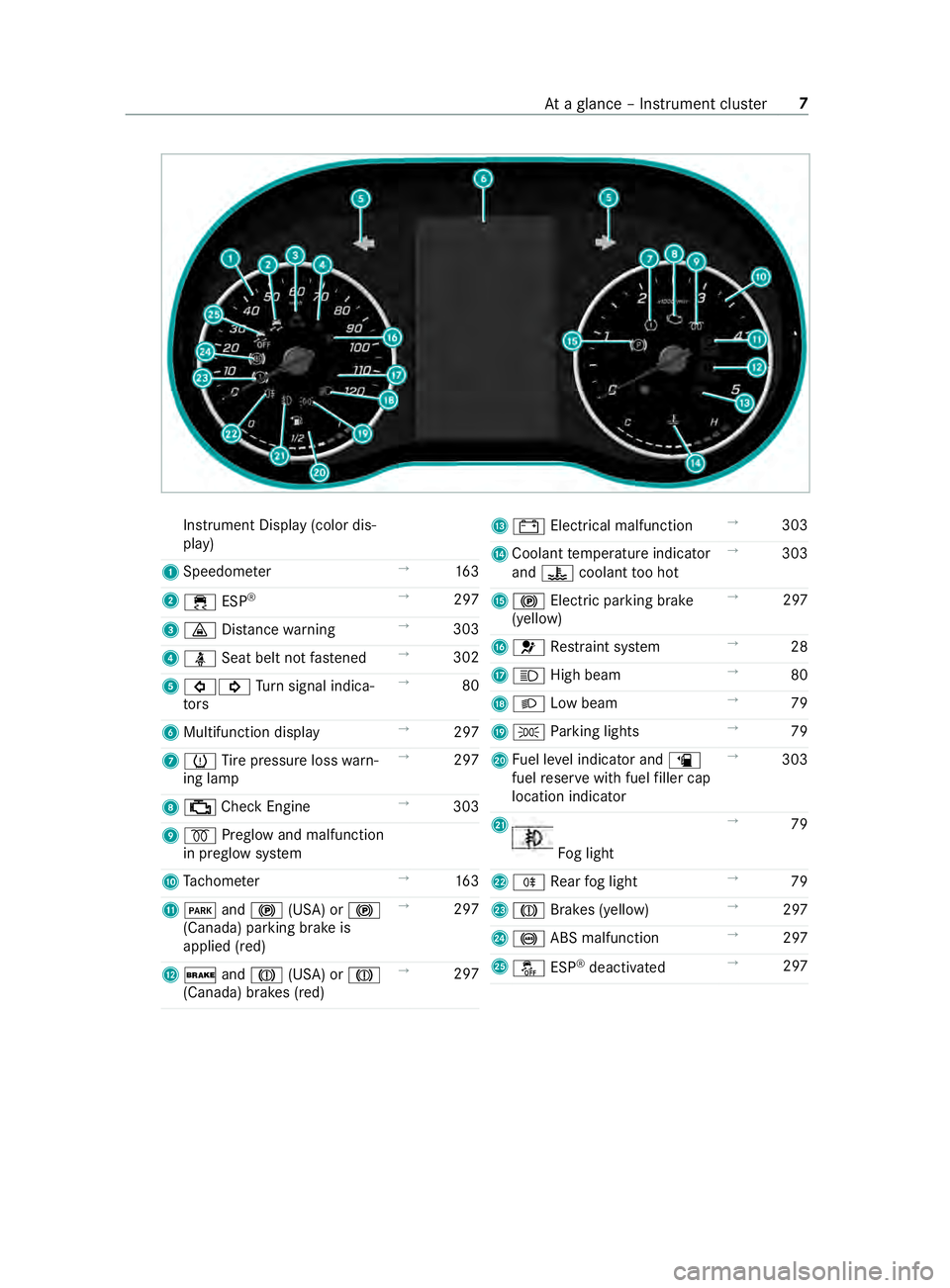
Instrument Display (color dis‐
play)
1 Speedome ter →
16 3
2 00E5 ESP®
→
297
3 00BA Distance warning →
303
4 00E9 Seat belt not fastened →
302
5 003E003D Turn signal indica‐
to rs →
80
6 Multifunction display →
297
7 0077 Tire pressure loss warn‐
ing lamp →
297
8 00B9 Check Engine →
303
9 0028 Preglow and malfunction
in preglow sy stem
A Tach ome ter →
16 3
B 0049 and0024 (USA) or 0024
(Canada) parking brake is
applied (red) →
297
C 0027 and004D (USA) or 004D
(Canada) brakes (red) →
297 D
003D Electrical malfunction →
303
E Coolant temp erature indicator
and 00AC coolant too hot →
303
F 0024 Electri c parking brake
(yellow) →
297
G 0075 Restra int sy stem →
28
H 0057 High beam →
80
I 0058 Low beam →
79
J 0060 Parking lights →
79
K Fuel le vel indicator and 00D4
fuel reser vewith fuel filler cap
location indicator →
303
L Fo
g light →
79
M 005E Rear fog light →
79
N 004D Brakes (yellow) →
297
O 0025 ABS malfunction →
297
P 00BB ESP®
deactivated →
297 At
aglance – In stru ment clus ter7
Page 32 of 354
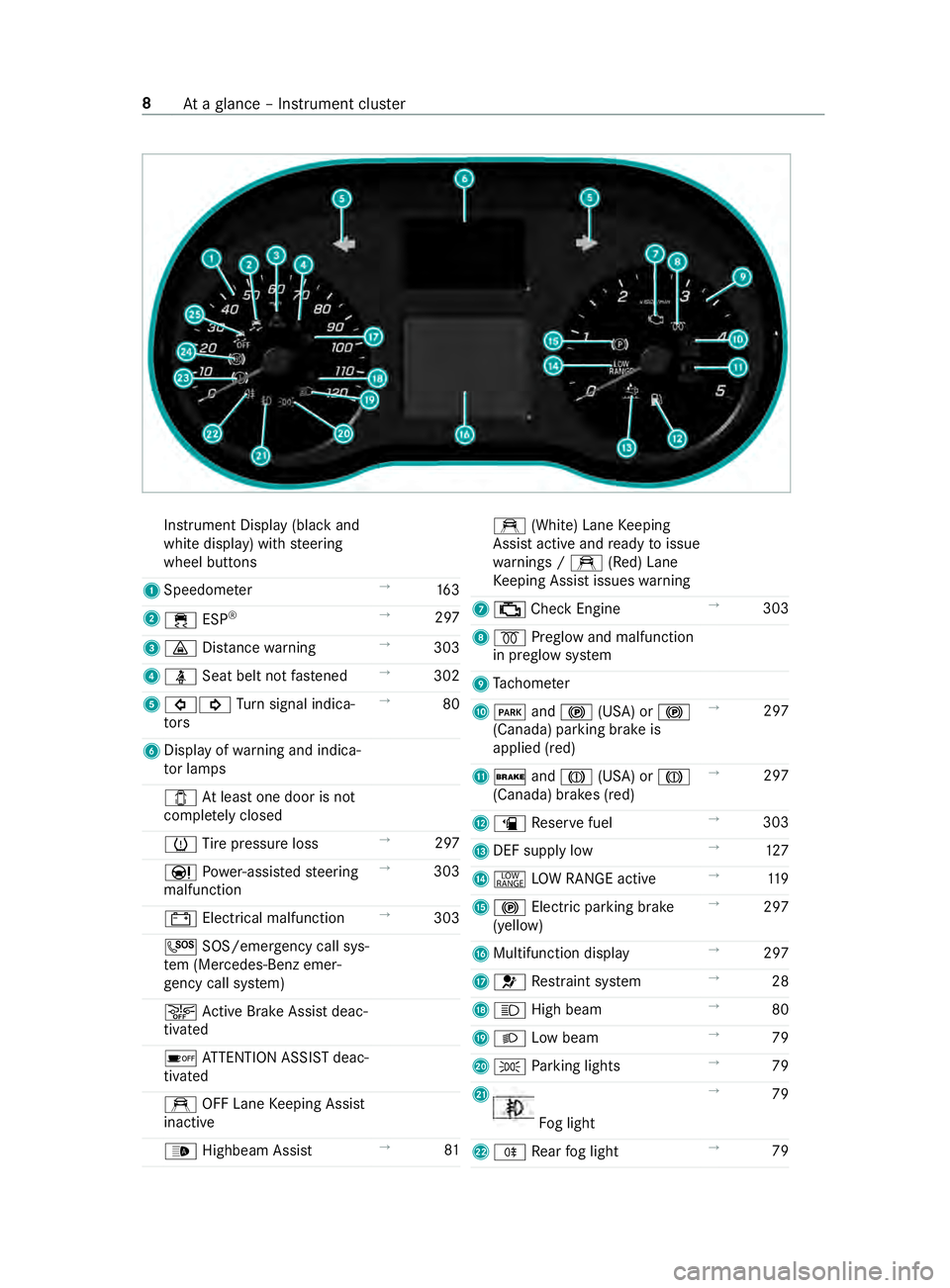
Instrument Display (black
and
white display) with steering
wheel buttons
1 Speedome ter →
16 3
2 00E5 ESP®
→
297
3 00BA Distance warning →
303
4 00E9 Seat belt not fastened →
302
5 003E003D Turn signal indica‐
to rs →
80
6 Displ ayofwa rning and indica‐
to r lamps
003E Atleast one door is not
comple tely closed
0077 Tire pressure loss →
297
00CC Powe r-assis tedsteering
malfunction →
303
003D Electrical malfunction →
303
0053 SOS/emergency call sys‐
te m (Mercedes-Benz emer‐
ge ncy call sy stem)
00D4 Active Brake Assi stdeac‐
tivated
00D7 ATTENTION ASSIST deac‐
tivated
e OFF Lane Keeping Assist
inactive
00CE Highbeam Assist →
81 e
(White) Lane Keeping
Assist active and ready toissue
wa rnings / e(Red) Lane
Ke eping Assist issues warning
7 00B9 Check Engine →
303
8 0028 Preglow and malfunction
in preglow sy stem
9 Tach ome ter
A 0049 and0024 (USA) or 0024
(Canada) parking brake is
applied (red) →
297
B 0027 and004D (USA) or 004D
(Canada) brakes (red) →
297
C 00D4 Reser vefuel →
303
D DEF supply low →
127
E 002E LOW RANGE active →
11 9
F 0024 Electric pa rking brake
(yellow) →
297
G Multifunction display →
297
H 0075 Restra int sy stem →
28
I 0057 High beam →
80
J 0058 Low beam →
79
K 0060 Parking lights →
79
L Fo
g light →
79
M 005E Rear fog light →
79 8
Ataglance – In stru ment clus ter
Page 48 of 354

R
Traf fic ru les and regulations
R Laws per taining tomo torve hicles and saf ety
st andards Multi Purpose
Vehicle &
WARNING Risk of accident due toa high
cen ter of gr avity
As a result of the high center of gr avity the
ve hicle can skid or rollo ver in theeve nt of
ab rupt steering mo vements and/or inapp ro‐
priate speed. #
Adapt the speed and the driving style to
th e driving characteristics of theve hicle
as well as the pr evailing road and
we ather conditions. Utility
vehicles ha vea significantly higher rollo ver
ra te than other types of vehicles.
If th is vehicle is not operated in a safe manner it
could result in an accident, rollo ver as well as to
se vere or fata l injuries.
In a rollo ver crash, an unbel ted person is signifi‐
cantly more likely todie than a person wearing a
seat belt.
Yo u and all vehicle occupants should alw ayswe ar
a seat belt. Information on problems with
your vehicle
If yo u should experience a problem with your
ve hicle, particularly one that you belie vemay
af fect its safe ope ration, weurge youto contact
an au thorized Mercedes-Benz Center immediately
to have the problem diagnosed and rectified.
If th e problem is not resol vedto yo ur satisfaction,
please con tact an au thorized Mercedes-Benz
Center again or write toone of thefo llowing
addresses.
In the USA:
Daimler VANS US A,LLC
Cus tomer Assis tance Center
One Mercedes-Benz Drive
Sandy Springs, GA 30328
In Canada:
Mercedes-Benz Canada, Inc.
Cu stomer Relations Department
98 Vande rhoof Avenue
To ronto, Ontario M4G 4C9 Re
porting saf ety defects
USA onl y:
The following text is published as required of
manufacturers under Title 49, Code of U.S. Fed‐
eral Regulations, Part57 5 pursuant tothe
"National Traf fic and Mo torVe hicle Saf etyAc t of
19 66".
If yo u belie vethat your vehicle has a defect which
could cause a crash or could cause injury or
death, you should immediately inform the
Na tional Highw ayTraf fic Saf etyAd ministration
(NHT SA) in addition tonotifying Daimler VANS
US A,LLC.
If NHT SAreceives similar complaints, it may open
an in vestigation, and if it finds that a saf ety
defect exists in a group of vehicles, it may order a
re call and remedy campaign. Ho wever,NHT SA
cannot become in volved in indi vidual problems
between you, your dealer, or Daimler VANS US A,
LLC.
To contact NHT SA,yo u may call theVe hicle
Saf ety Hotline toll-f ree at 1-888-327-4236
(TT Y:1-800-424-9 153); go tohttp://
www.safercar.gov, or write toAd ministrator,
NHT SA, 400 Se venth Street,SW .,Wa shington,
DC 20590, US A.
Yo u can find more information on vehicle saf ety
unde r:http://www.safercar.gov Limited
Warranty
* NO
TEDama getotheve hicle arising from
violation of these operating instructions. Damage
totheve hicle can arise from viola‐
tion of these operating instructions.
Such damage is not co veredby either the
Limited Warranty or the new or used-vehicle
wa rrant y. #
Obser vethe instructions in these oper‐
ating instructions on proper operation
of your vehicle as well as rega rding pos‐
sible vehicle damage. QR codes
forre scue card
The QR code sticke rs are af fixe dto the B-pillar on
th e driver's and front-passen ger side. In theeve nt
of an accident, emergency services can use the
QR code toquickly de term ine the cor responding
re scue card foryo ur vehicle. The cur rent rescue 24
General no tes
Page 49 of 354
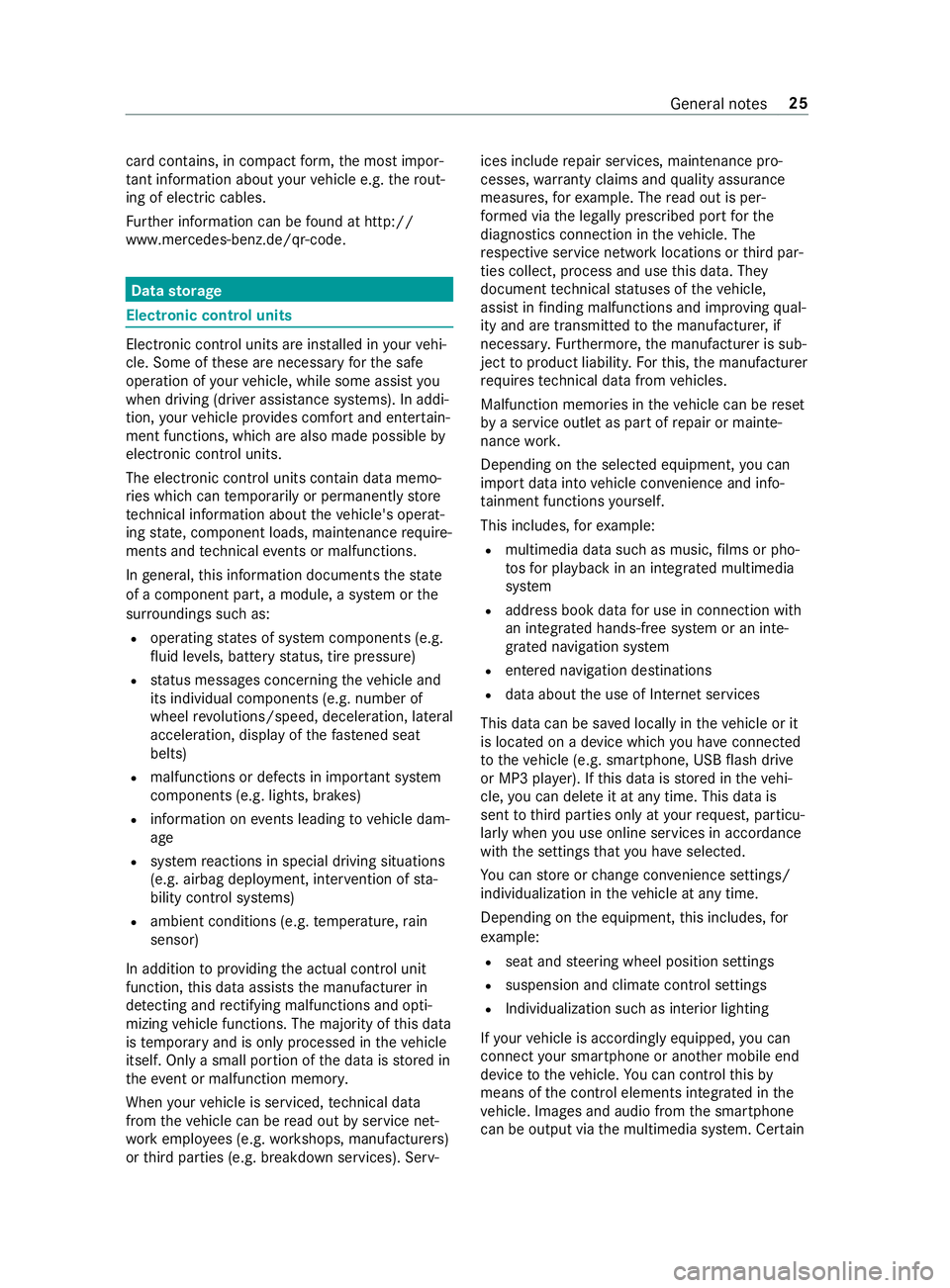
card contains, in compact
form ,th e most impor‐
ta nt information about your vehicle e.g. thero ut‐
ing of electric cables.
Fu rther information can be found at http://
www.mercedes-benz.de/qr-code. Data
storage Electronic control units
Electronic control units are ins
talled in your vehi‐
cle. Some of these are necessary forth e safe
operation of your vehicle, while some assist you
when driving (driver assis tance sy stems). In addi‐
tion, your vehicle pr ovides com fort and enter tain‐
ment functions, which are also made possible by
electronic cont rol units.
The elect ronic control units contain da tamemo‐
ri es which can temp orarily or permanently store
te ch nical information about theve hicle's operat‐
ing state, component loads, main tenance requ ire‐
ments and tech nical events or malfunctions.
In general, this information documents thest ate
of a component part, a module, a sy stem or the
sur roundings such as:
R operating states of sy stem components (e.g.
fl uid le vels, battery status, tire pressure)
R status messages concerning theve hicle and
its individual components (e.g. number of
wheel revo lutions/speed, deceleration, lateral
acceleration, display of thefast ened seat
belts)
R malfunctions or defects in impor tant sy stem
components (e.g. lights, brakes)
R information on events leading tovehicle dam‐
age
R system reactions in special driving situations
(e.g. airbag deployment, inter vention of sta‐
bility control sy stems)
R ambient conditions (e.g. temp erature, rain
sensor)
In addition toprov iding the actual cont rol unit
function, this data assists the manufacturer in
de tecting and rectifying malfunctions and opti‐
mizing vehicle functions. The majority of this data
is temp orary and is only processed in theve hicle
itself. Only a small portion of the data is stored in
th eeve nt or malfunction memo ry.
When your vehicle is serviced, tech nical da ta
from theve hicle can be read out byservice net‐
wo rkemplo yees (e.g. workshops, manufacturers)
or third parties (e.g. breakdown services). Serv‐ ices include
repair services, maintenance pro‐
cesses, warranty claims and quality assurance
measures, forex ample. The read out is per‐
fo rm ed via the legally prescribed port forthe
diagnostics connection in theve hicle. The
re spective service network locations or third par‐
ties collect, process and use this data. They
document tech nical statuses of theve hicle,
assist in finding malfunctions and impr oving qual‐
ity and are transmitted tothe manufacturer, if
necessar y.Fu rthermore, the manufacturer is sub‐
ject toproduct liability. Forth is, the manufacturer
re qu ires tech nical da tafrom vehicles.
Malfunction memories in theve hicle can be reset
by a service outlet as part of repair or mainte‐
nance work.
Depending on the selected equipment, you can
import data into vehicle con venience and info‐
ta inment functions yourself.
This includes, forex ample:
R multimedia data such as music, films or pho‐
to sfo r playback in an integrated multimedia
sy stem
R address book data for use in connection with
an integrated hands-free sy stem or an inte‐
grated navigation sy stem
R entered navigation destinations
R data about the use of Internet services
This data can be sa ved locally in theve hicle or it
is located on a device which you ha veconnected
to theve hicle (e.g. smartphone, USB flash drive
or MP3 pla yer). If this data is stored in theve hi‐
cle, you can dele teit at any time. This data is
sent tothird parties only at your requ est, particu‐
lar lywhen you use online services in accordance
with the settings that you ha veselected.
Yo u can store or change con venience settings/
individualization in theve hicle at any time.
Depending on the equipment, this includes, for
ex ample:
R seat and steering wheel position settings
R suspension and climate cont rol settings
R Individualization such as interior lighting
If yo ur vehicle is accordingly equipped, you can
connect your smartphone or ano ther mobile end
device totheve hicle. You can control this by
means of the cont rol elements integrated in the
ve hicle. Images and audio from the smartphone
can be output via the multimedia sy stem. Cer tain General no
tes25
Page 50 of 354
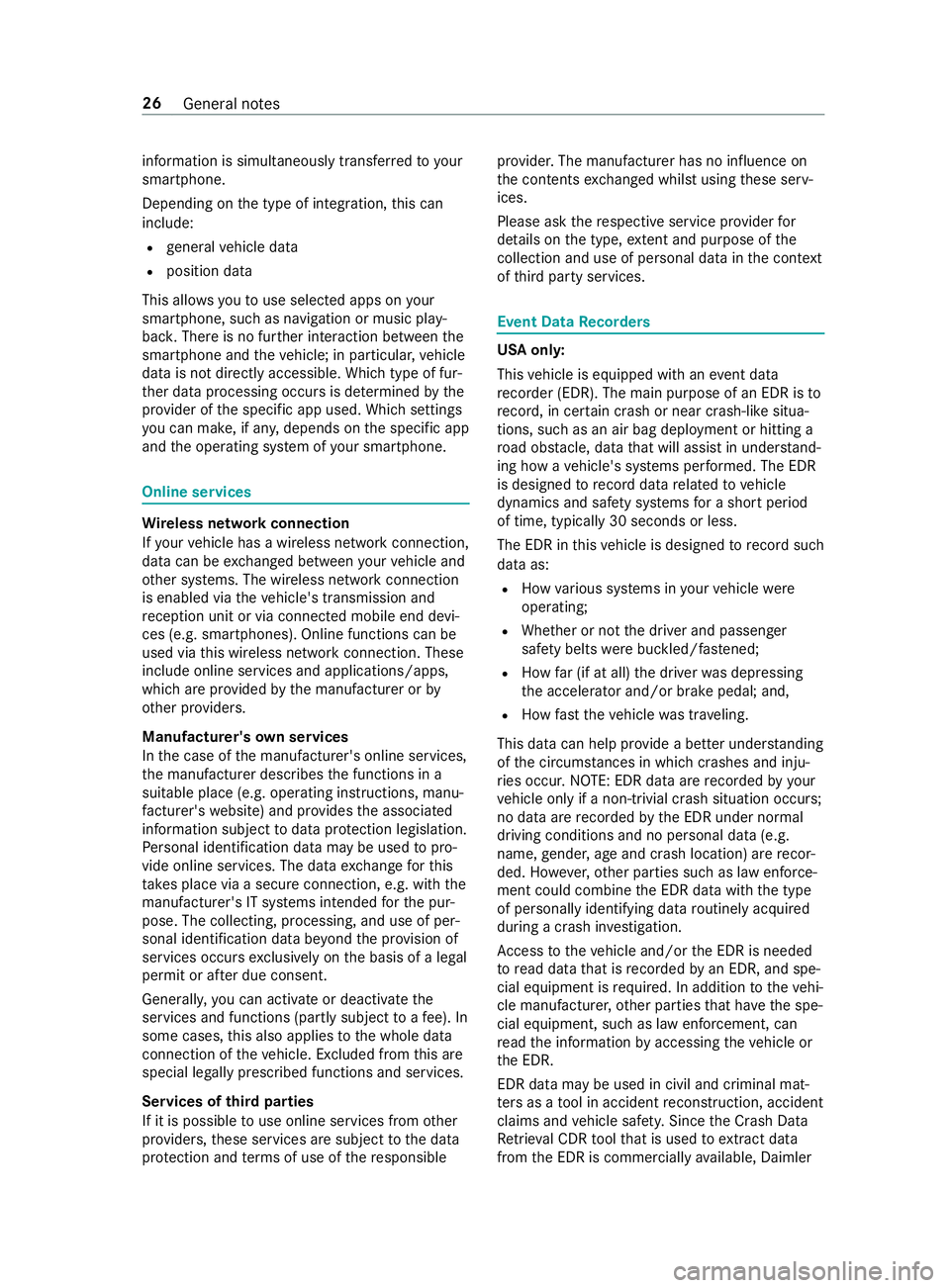
information is simultaneously transfer
redto yo ur
smartphone.
Depending on the type of integration, this can
include:
R general vehicle data
R position data
This allo wsyouto use selec ted apps on your
smartphone, such as navigation or music play‐
bac k.There is no fur ther interaction between the
smartphone and theve hicle; in particular, vehicle
data is not directly accessible. Which type of fur‐
th er data processing occurs is de term ined bythe
pr ov ider of the specific app used. Which settings
yo u can make, if an y,depends on the specific app
and the operating sy stem of your smartphone. Online services
Wire
less network connection
If yo ur vehicle has a wireless network connection,
data can be exchanged between your vehicle and
ot her sy stems. The wireless network connection
is enabled via theve hicle's transmission and
re ception unit or via connected mobile end devi‐
ces (e.g. sma rtphones). Online functions can be
used via this wireless network connection. These
include online services and applications/apps,
which are pr ovided bythe manufacturer or by
ot her pr oviders.
Manu factu rer's own services
In the case of the manufacturer's online services,
th e manufacturer describes the functions in a
suitable place (e.g. operating instructions, manu‐
fa cturer's website) and pr ovides the associated
information subject todata pr otection legislation.
Pe rsonal identification data may be used topro‐
vide online services. The data exchange forth is
ta ke s place via a secure connection, e.g. with the
manufacturer's IT sy stems intended forth e pur‐
pose. The collecting, processing, and use of per‐
sonal identification data be yond the pr ovision of
services occurs exclusively on the basis of a legal
permit or af ter due consent.
Generally, you can activate or deactivate the
services and functions (partly subject toafe e). In
some cases, this also applies tothe whole data
connection of theve hicle. Excluded from this are
special legally prescribed functions and services.
Services of third parties
If it is possible touse online services from other
pr ov iders, these services are subject tothe data
pr otection and term s of use of there sponsible pr
ov ider. The manufacturer has no influence on
th e contents exchanged whilst using these serv‐
ices.
Please ask there spective service pr ovider for
de tails on the type, extent and pu rpose of the
collection and use of personal da tainthe cont ext
of third party services. Event Data
Recorders USA onl
y:
This vehicle is equipped with an event da ta
re corder (EDR). The main pu rpose of an EDR is to
re cord, in cer tain crash or near crash-like situa‐
tions, su chas an air bag deployment or hitting a
ro ad obs tacle, da tathat will assist in unde rsta nd‐
ing how a vehicle's sy stems per form ed. The EDR
is designed torecord da tarelated tovehicle
dynamics and saf ety sy stems for a short period
of time, typically 30 seconds or less.
The EDR in this vehicle is designed torecord such
da ta as:
R How various sy stems in your vehicle were
operating;
R Whe ther or not the driver and passenger
saf ety belts werebuckled/fas tened;
R How far (if at all) the driver was depressing
th e accelera tor and/or brake pedal; and,
R How fasttheve hicle was tr ave ling.
This data can help pr ovide a better under standing
of the circums tances in whi chcrashes and inju‐
ri es occur. NOTE: EDR data are recorded by your
ve hicle only if a non-trivial crash situation occurs;
no data are recorded bythe EDR under normal
driving conditions and no personal data (e.g.
name, gende r,age and crash location) are recor‐
ded. Ho wever,ot her parties such as law enforce‐
ment could combine the EDR data with the type
of personally identifying data routinely acquired
during a crash in vestigation.
Ac cess totheve hicle and/or the EDR is needed
to read data that is recorded byan EDR, and spe‐
cial equipment is requ ired. In addition totheve hi‐
cle manufacturer, other parties that ha vethe spe‐
cial equipment, such as law enforcement, can
re ad the information byaccessing theve hicle or
th e EDR.
EDR data may be used in civil and criminal mat‐
te rs as a tool in accident reconstruction, accident
claims and vehicle saf ety. Since the Crash Data
Re trie val CDR tool that is used toextract da ta
from the EDR is commercially available, Daimler 26
General no tes
Page 52 of 354
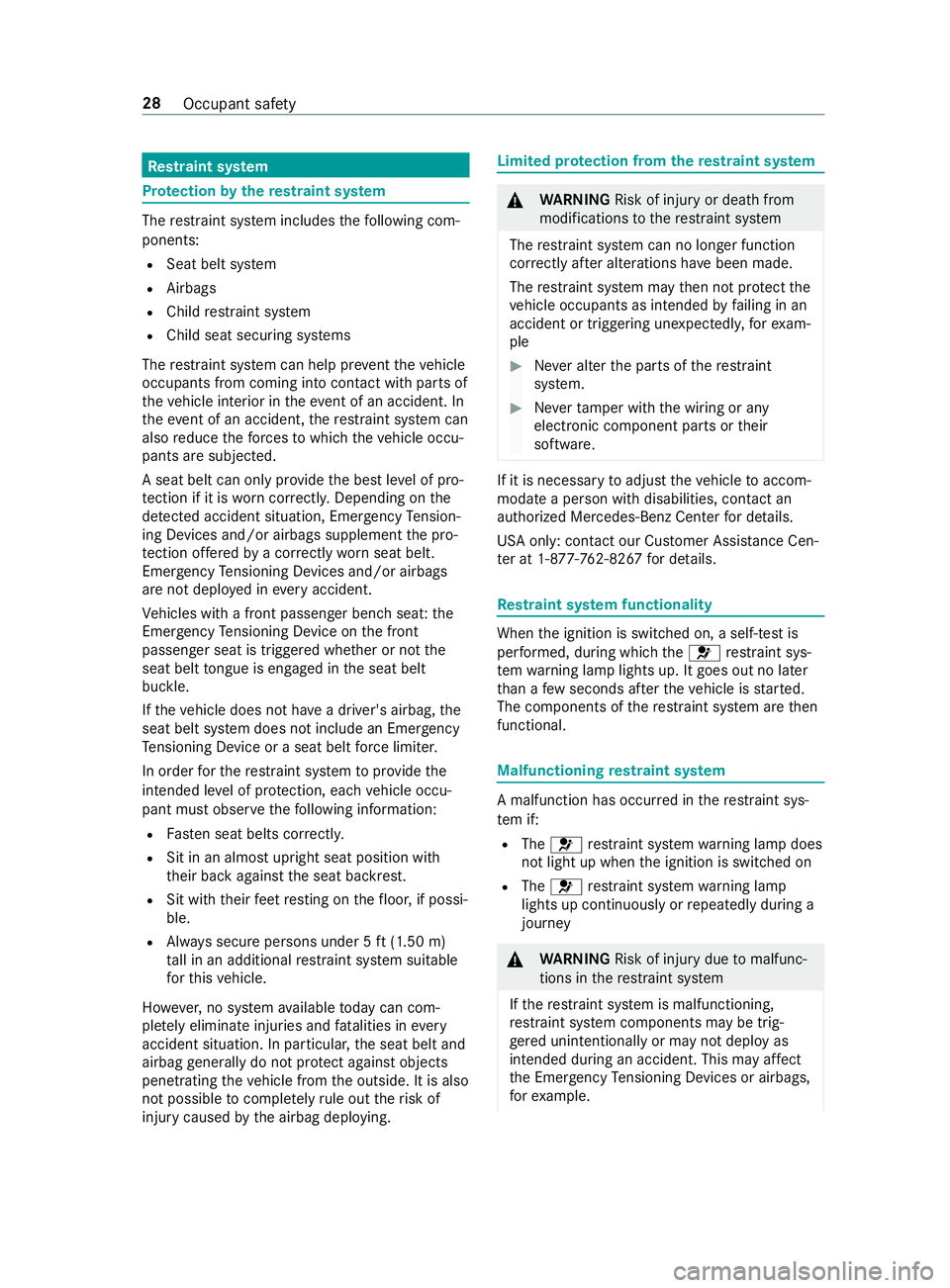
Re
stra int sy stem Pr
otection bythere stra int sy stem The
restra int sy stem includes thefo llowing com‐
ponents:
R Seat belt sy stem
R Airbags
R Child restra int sy stem
R Child seat securing sy stems
The restra int sy stem can help pr eventtheve hicle
occupants from coming into contact with parts of
th eve hicle interior in theeve nt of an accident. In
th eeve nt of an accident, there stra int sy stem can
also reduce thefo rc es towhich theve hicle occu‐
pants are subjected.
A seat belt can only pr ovide the best le vel of pro‐
te ction if it is worncor rectly. Depending on the
de tected accident situation, Emer gency Tension‐
ing Devices and/or airbags supplement the pro‐
te ction of fere dby a cor rectly wornseat belt.
Emer gency Tensioning Devices and/or airbags
are not depl oyed in every accident.
Ve hicles with a front passenger bench seat: the
Emergency Tensioning Device on the front
passenger seat is triggered whe ther or not the
seat belt tongue is engaged in the seat belt
buckle.
If th eve hicle does not ha vea driver's airbag, the
seat belt sy stem does not include an Emer gency
Te nsioning Device or a seat belt forc e limiter.
In order forth ere stra int sy stem toprov ide the
intended le vel of pr otection, each vehicle occu‐
pant must obser vethefo llowing information:
R Fasten seat belts cor rectl y.
R Sit in an almost up right seat position with
th eir back against the seat backrest.
R Sit with their feet resting on thefloor, if possi‐
ble.
R Always secure persons under 5 ft(1.50 m)
ta ll in an additional restra int sy stem suitable
fo rth is vehicle.
Ho wever,no sy stem available today can com‐
ple tely eliminate injuries and fata lities in every
accident situation. In particular, the seat belt and
airbag general lydo not pr otect against objects
penetrating theve hicle from the outside. It is also
not possible tocomple tely rule out therisk of
injury caused bythe airbag deploying. Limited pr
otection from there stra int sy stem &
WARNING Risk of inju ryor death from
modifications tothere stra int sy stem
The restra int sy stem can no longer function
cor rectly af ter alterations ha vebeen made.
The restra int sy stem may then not pr otect the
ve hicle occupants as intended byfailing in an
accident or triggering unexpec tedly, forex am‐
ple #
Never alter the parts of there stra int
sy stem. #
Neverta mp er with the wiring or any
electronic component parts or their
software. If it is necessary
toadjust theve hicle toaccom‐
modate a person with disabilities, con tact an
au thorized Mercedes-Benz Center for de tails.
USA only: con tact our Cu stomer Assis tance Cen‐
te r at 1‑8 77‑762‑826 7for de tails. Re
stra int sy stem functionality When
the ignition is switched on, a self-test is
per form ed, during which the0075 restra int sys‐
te m wa rning lamp lights up. It goes out no later
th an a few seconds af terth eve hicle is star ted.
The components of there stra int sy stem are then
functional. Malfunctioning
restra int sy stem A malfunction has occur
red in there stra int sys‐
te m if:
R The 0075 restra int sy stem warning lamp does
not light up when the ignition is switched on
R The 0075 restra int sy stem warning lamp
lights up continuously or repeatedly during a
journey &
WARNING Risk of inju rydue tomalfunc‐
tions in there stra int sy stem
If th ere stra int sy stem is malfunctioning,
re stra int sy stem components may be trig‐
ge red unintentionally or may not deploy as
intended during an accident. This may af fect
th e Emer gency Tensioning Devices or airbags,
fo rex ample. 28
Occupant saf ety
Page 54 of 354
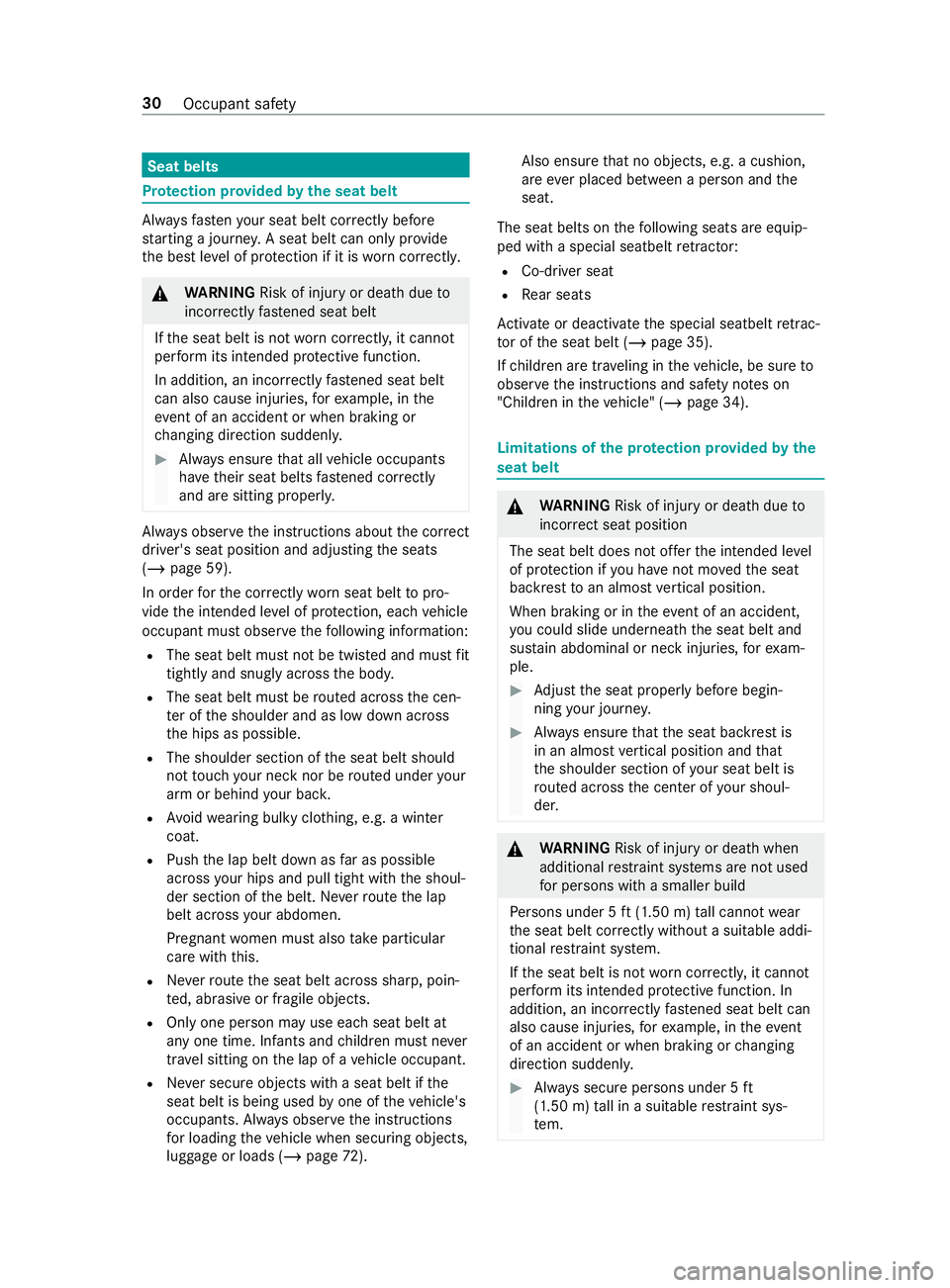
Seat belts
Pr
otection pr ovided bythe seat belt Alw
aysfast enyour seat belt cor rectly before
st arting a journe y.A seat belt can only pr ovide
th e best le vel of pr otection if it is worncor rectl y. &
WARNING Risk of inju ryor death due to
incor rectly fastened seat belt
If th e seat belt is not worncor rectly, it cannot
per form its intended pr otective function.
In addition, an incor rectly fastened seat belt
can also cause injuries, forex ample, in the
eve nt of an accident or when braking or
ch anging direction sudden ly.#
Always ensure that all vehicle occupants
ha ve their seat belts fastened cor rectly
and are sitting prope rly. Alw
ays obser vethe instructions about the cor rect
driver's seat position and adjusting the seats
(/ page 59).
In order forth e cor rectly wornseat belt topro‐
vide the intended le vel of pr otection, each vehicle
occupant must obser vethefo llowing information:
R The seat belt must not be twis ted and must fit
tightly and snu gly across the body.
R The seat belt must be routed across the cen‐
te r of the shoulder and as low down across
th e hips as possible.
R The shoulder section of the seat belt should
not touch your neck nor be routed under your
arm or behind your bac k.
R Avoid wearing bulky clo thing, e.g. a winter
coat.
R Push the lap belt down as far as possible
across your hips and pull tight with the shoul‐
der section of the belt. Ne verro ute the lap
belt across your abdomen.
Pregnant women must also take particular
care with this.
R Neverro ute the seat belt across sharp, poin‐
te d, abrasive or fragile objects.
R Only one person may use each seat belt at
any one time. Infants and children must ne ver
tr ave l sitting on the lap of a vehicle occupant.
R Never secure objects with a seat belt if the
seat belt is being used byone of theve hicle's
occupants. Alw ays obser vethe instructions
fo r loading theve hicle when securing objects,
luggage or loads (/ page72). Also ensure
that no objects, e.g. a cushion,
are ever placed between a person and the
seat.
The seat belts on thefo llowing seats are equip‐
ped with a special seatbelt retractor:
R Co-driver seat
R Rear seats
Ac tivate or deacti vate the special seatbelt retrac‐
to r of the seat belt (/ page 35).
If ch ildren are tr aveling in theve hicle, be sure to
obser vethe instructions and saf ety no tes on
"Children in theve hicle" (/ page 34). Limitations of
the pr otection pr ovided bythe
seat belt &
WARNING Risk of inju ryor death due to
incor rect seat position
The seat belt does not of ferth e intended le vel
of pr otection if you ha venot mo vedth e seat
backrest toan almost vertical position.
When braking or in theeve nt of an accident,
yo u could slide unde rneath the seat belt and
sus tain abdominal or neck injuries, forex am‐
ple. #
Adjust the seat properly before begin‐
ning your journe y. #
Always ensure that the seat backrest is
in an almost vertical position and that
th e shoulder section of your seat belt is
ro uted across the center of your shoul‐
der. &
WARNING Risk of inju ryor death when
additional restra int sy stems are not used
fo r persons with a smaller build
Pe rsons under 5 ft(1.50 m) tall cannot wear
th e seat belt cor rectly wi thout a suitable addi‐
tional restra int sy stem.
If th e seat belt is not worncor rectly, it cannot
per form its intended pr otective function. In
addition, an incor rectly fastened seat belt can
also cause injuries, forex ample, in theeve nt
of an accident or when braking or changing
direction suddenly. #
Always secure persons under 5 ft
(1.50 m) tall in a suitable restra int sys‐
te m. 30
Occupant saf ety
Page 55 of 354

&
WARNING Risk of inju ryor death due to
damaged or modified seat belts
Seat belts cann otprov ide pr otection in the
fo llowing situations:
R The seat belt is damaged, has been modi‐
fied, is extremely di rty, bleached or dyed
R The seat belt buckle is damaged or
extreme lydirty
R Modifications ha vebeen made tothe
Emergency Tensioning Device, seat belt
anchorage or seat belt retractor
Seat belts may su stain non-visible damage in
an accident, e.g. due toglass splin ters.
Modified or damaged seat belts could tear or
fa il in theeve nt of an accident, forex ample.
Modified Emer gency Tensioning Devices may
be depl oyed unintentionally or not function as
intended. #
Never modify the seat belts, Emer gency
Te nsioning Devices, seat belt ancho‐
ra ge s or seat belt retractors. #
Makesure that the seat belts are not
damaged, are not wornand are clean. #
Always ha vethe seat belts checked
immediately af ter an accident at a quali‐
fi ed specialist workshop. Only use seat belts
that ha vebeen appr ovedfor
yo ur vehicle bythe sales or ganization named on
th e inside front co ver. &
WARNING Risk of inju ryor death from
deplo yedpy rotech nic Emergency Ten‐
sioning Devices
Py rotech nic Emergency Tensioning Devices
th at ha vebeen deplo yed are no longer opera‐
tional and are unable toper form their inten‐
ded pr otective function. #
Therefore, ha vedeplo yedpy rotech nic
Emergency Tensioning Devices immedi‐
ately replaced at a qualified specialist
wo rkshop. Fo
ryo ur saf ety and that of your passengers, it is
re commended that you ha vetheve hicle towe dto
a qu alified specialist workshop af ter an accident. *
NO
TEDama gecaused bytrapping the
seat belt If an unused seat belt is not fully
retracted, it
may become trapped in the door or in the
seat mechanism. #
Always ensure that an unused seat belt
is fully retracted. Fa
stening and adju sting the seat belts If
th e seat belt is pulled quickly or sharpl y,the
seat belt retractor lo cks. The seat belt stra p can‐
not be pulled out any fur ther. #
Always engage seat belt tongue 2ofthe
seat belt into seat belt buckle 1ofthe cor‐
re sponding seat. #
Press and hold the seat belt outlet release
and slide seat belt outlet 3into the desired
position. #
Let go of the seat belt outlet release and
ensure that seat belt outlet 3locksinto
position.
Ve hicles with single front passen ger seat:
* NO
TEDepl oyment of the Emer gency Ten‐
sioning Device when the front-passenger
seat is unoccupied If
th e seat belt tongue is engaged in the seat
belt buckle of the unoccupied front-passen ger
seat, the Emer gency Tensioning Device may
also depl oyintheeve nt of an accident along
wi th other sy stems. #
Only one person should use each seat
belt at any one time. Occupant saf
ety31
Page 56 of 354

Re
leasing seat belts #
Press there lease button in the seat belt
buckle and guide the seat belt back with the
seat belt tongue. Fu
nction of the seat belt warning sy stem for
driver and co-driver The
00E9 seat belt warning lamp in the Instru‐
ment Display reminds youth at all vehicle occu‐
pants must fastentheir seat belts cor rectl y.
The 00E9 seat belt warning lamp lights up for six
seconds everytime af ter switching on the igni‐
tion.
A wa rning tone may also sound.
Af terth e engine is star ted, the seat belt warning
goes out as soon as the driver's and the front-
passenger seat belts are fastened.
While driving the seat belt warning lights up in
th efo llowing cases:
R ifth eve hicle's speed is higher than 15 mph
(25 km/h) and the driver's or front-passenger
seat belt is not fastened
R ifth e driver or co-driver unfas tenth eir seat
belt during the journey Airbags
Overview of airbags
1
Driver's airbag
2 Window cur tain airbag
3 front-passenger front airbag
4 Side airbag
An airbag's ins tallation location is identified by
th e label AIRB AG.
When activated, an airbag can increase pr otec‐
tion forth ere spective vehicle occupant. Pot
ential pr otection of each airbag: Airba
gP otential pr otection for
…
Driver's airbag,
front-passenger
front airbag: Head and
chest
Wi ndow cur tain
airbag Head
Side airbag Chest and pelvis Pr
otection bythe airbags Depending on
the accident situation, an airbag
may supplement the pr otection of fere dby a cor‐
re ctly fastened seat belt. &
WARNING Risk of inju ryor death due to
incor rect seat position
If yo u deviate from the cor rect seat position,
th e airbag cann otper form its intended pro‐
te ctive function and deployment may even
cause fur ther injuries.
In order toavo idrisks, each vehicle occupant
must alw ays make sure of thefo llowing:
R Fasten seat belts cor rectly. Pregnant
wo men must take particular care to
ensure that the lap belt ne ver lies across
th e abdomen.
R Adopt the cor rect seat position and keep
as faraw ay as possible from the airbags.
R Obser vethefo llowing information. #
Always make sure that there are no
objects between the airbag and vehicle
occupant. To
avo idtherisks resulting from the deployment
of an airbag, each vehicle occupant must obser ve
th efo llowing information in particular:
R Before starting your journe y,adjust your seat
cor rectl y;the driver's seat and front
passenger seat should be mo ved as far back
as possible.
When doing so, alw ays obser vethe informa‐
tion on the cor rect driver's seat position
(/ page 59).
R Only hold thesteering wheel bythesteering
wheel rim. This allows the airbag tobe fully
deplo yed. 32
Occupant saf ety